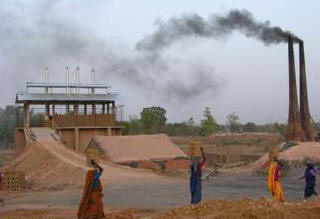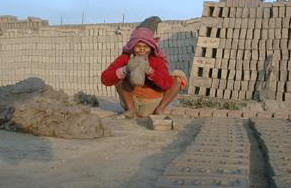| Towards the Greening of Brick Industry The Indian brick industry is currently based on decentralized production using energy intensive, resource depleting and highly polluting technologies and production methods. Due to regulatory pressure they are confronted with environmental regulation and face several challenges for its survival; especially small scale brick entrepreneurs High air pollution
Environmental degradation and the problem of compliance Massive scale environmental degradation is caused through unorganized and wide scale brick production activities. The indiscriminate usage of top soil in brick making remains a serious issue. Approximately 2.2 billion cubic metre of clay/silt is utilized every year for brick making i.e. top soil of 2200 sq. km of surface land is scooped out up to a depth of 1 metre every year, leaving it infertile for future use. Risky for small scale entrepreneurs The present nature of brick business experiences very high vulnerability from uncertainties in weather conditions, frequent changes in soil quality, poor control over the quality of fuel and technology. A significant uncertainty in production costs in the brick industry is on account of fuel usage which accounts for 30% of the production cost. With unabated increase in the price of coal and higher costs of transportation, this cost factor is beyond the control of the brick entrepreneurs. Alternatives yet to be proven The brick kiln owners, threatened with closure, are reluctant to change over to alternative technology solutions. This is largely due to the fact that new technology solutions have been demonstrated only on a limited scale, with claims of the new kilns being largely unproven. The problem is the absence of critical presence of commercially proven alternatives. Deteriorating socio-economic / working conditions The workers in the brick industry are subject to extreme working conditions and poor remuneration. The brick moulder families are contracted through middlemen and usually belong to poor districts of Uttar Pradesh, Bihar, Chattisgarh and Orissa. Their employment pattern is also seasonal. Tight margins in the brick market coupled with rising costs of energy result in poor remuneration for the majority of brick workers and deterioration in the quality of their life. Need for sustained dissemination There is an urgent need to demonstrate large scale and positive environmental impact in brick making clusters. To achieve this, focused support is needed for dissemination of improved brick technology in new brick clusters affected by environmental regulation. The demand for new technology solutions can be organized through regional collaboration between brick associations and state level institutions. Similarly, the supply of the technology can be anchored in the commercial market within a business network. A project initiative is needed for coordinated action by different stakeholders for building the capacity of regional institutions and business networks for sustained dissemination of improved brick technologies on a substantially large scale. Programme components The programme aims to employ an overarching strategy of Capacity Building to facilitate a collaborative relationship between different stakeholders to work actively towards improving the environmental and social conditions in the brick sector. The programme has two distinct components: Enhanced participation to enable informed decision making A stakeholder network involving brick associations, regulatory agencies, and policy makers will be enabled to exercise positive influence to emerging environmental legislation. In contrast to threats of closure, the entrepreneur will be confronted with technological and business solutions that can be customized to the market and livelihood needs of the brick worker community, and respond to tightening environmental norms. Capacity building to leverage market competencies This component is directed towards strengthening supply of skilled manpower in the brick sector and business interests of market based service providers. The network of business development associates, equipment and service suppliers will be strengthened in promoting environmentally sound technology solutions. The overall goal and purpose of the programme has been defined as follows: Goal Contribute to India’s capacity to promote environmentally sound development in energy sector. Purpose Build capacity within brick industry for enhanced environmental benefits through sustained dissemination of VSBK technology. Programme strategy The purpose and objectives of the project have been planned to be achieved through a three pronged strategy that integrates
A clear focus of the strategy would be intense stakeholder engagement. A stakeholder platform will be used for awareness creation regarding environmental solutions in the brick sector. Through the engagement process, demand will be created with support of local Brick Associations. Promotion assistance would be organized with the State Pollution Control Boards and financing institutions. In the market environment, a network of commercial service providers would be created for delivery of critical services, hardware and software support. Capacity building efforts will be directed at specialized masons, brick moulders, fire masters and production supervisors to create a reservoir of trained manpower. A significant component would be engaging with the brick community to establish protocols for training and skill building. Technology solutions would be designed and customized to achieve high levels of resource efficiency. Focus would be on practices that conserve soil by reducing process breakages, encourage substitution with industrial waste materials like fly ash and stone dust and further reduce the energy consumption. The Greening of Brick Industry programme is managed by Development Alternatives (DA), responsible for capacity building, technology support, environmental monitoring, community initiatives and project management. Technology promotion, construction and commissioning of kilns, delivery network servicing and engagement of business intermediaries is being carried out by TARA. Thrust areas The demand for bricks in the newly formed state of Chattisgarh and Jharkhand is rising exponentially for construction of new infrastructure and buildings. The regulatory authorities and industrial promotion agencies of Jharkhand, Chattisgarh and Madhya Pradesh have expressed a desire to formulate policies that are conducive for speedy adoption of the Vertical Shaft Brick Kiln technology. A series of Business Opportunity Workshops have already been conducted, to provide exposure to the VSBK technology at Raipur, Gwalior, Indore, Ranchi and Dhanbad. Target groups and beneficiaries: Target Groups 1. Affected movable chimney kiln owners, who are forced to close down their kiln after enforcement of the ban on movable chimneys. 2. New entrepreneurs who would like to enter into brick production business with a green technology. 3. Local manpower benefiting from skill based training and brick worker community groups who would like to own and manage brick enterprises. 4. Network of commercial service providers and business development associates. Beneficiaries 1. Environment
2. Brick workers
3. Entrepreneurs
4. Regulatory bodies
Dr. Soumen Maity |

 Primary focus of the programme are the states of Chattisgarh, Madhya Pradesh, Orissa and Jharkhand. The brick production in these states is predominantly through movable chimney kilns and diverse clamps; both small and large. The annual production capacity varies between 5 lakhs for small clamps and upto 20 lakhs for large clamps and movable chimney kilns. Entrepreneurs of these states are in a fix as they do not have any technological option other than switching to fixed chimney kilns, which are mostly not feasible in terms of investment requirements and market conditions.
Primary focus of the programme are the states of Chattisgarh, Madhya Pradesh, Orissa and Jharkhand. The brick production in these states is predominantly through movable chimney kilns and diverse clamps; both small and large. The annual production capacity varies between 5 lakhs for small clamps and upto 20 lakhs for large clamps and movable chimney kilns. Entrepreneurs of these states are in a fix as they do not have any technological option other than switching to fixed chimney kilns, which are mostly not feasible in terms of investment requirements and market conditions.